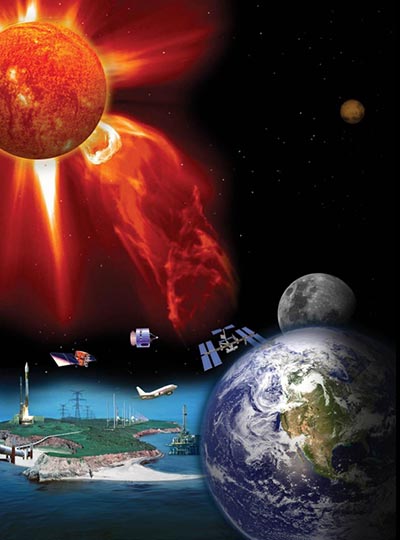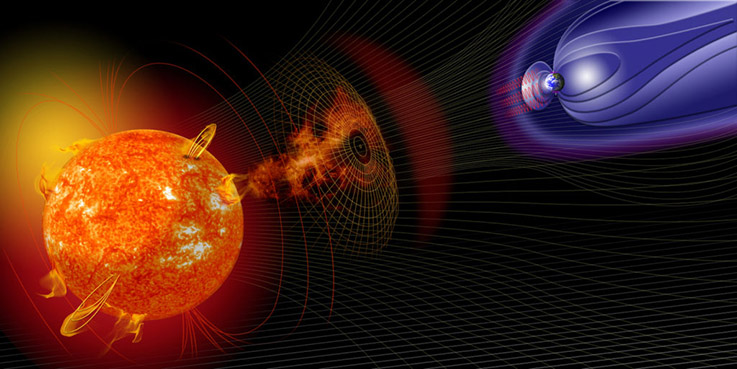From Cyberattack to Solar Attack
The small-scale cyberattack, characteristic of the late-twentieth century, has long dominated discourses and practices of data center security. Lately, however, these fears are increasingly giving way to concerns over large-scale, existential risks posed by solar activity. Increasing numbers of data centers are going to extreme measures to protect their facilities from solar flares, solar energetic particles and Coronal Mass Ejections – collectively referred to as “space weather”. As data centers are put into circulation with what Georges Bataille famously called the sun’s “superabundance of energy” (1991:29), the act of protecting digital-industrial infrastructure takes on strangely mythical dimensions. In this post, I would like to briefly explore the business end of the mythical dispositif that arises from the surreal and distinctly Bataillean meeting of data centers and the sun.
The Solar Monster

NASA poster showing technology and infrastructure that can be affected by space weather events. Credit: NASA
In the last decade, space weather has been brought into political organization as a “global risk” for our increasingly technologized planet.[i] The sun regularly ejects plasma and other charged material into the heliosphere during solar storms. If these solar particles are released in Earth’s direction they can trigger global changes in the planet’s magnetic field, which “explosively releases” this electromagnetic energy towards the surface of the Earth (Royal Academy of Engineering 2013:19). This energy can induce high-voltage currents in conducting material such as wires and electronic circuits, short-circuiting or even melting electromechanical components. A similar effect occurs when nuclear bombs are detonated at high altitudes – the gamma rays released from the blast rip electrons and atoms apart in the atmosphere, creating an invisible pulse of energy known as an “electromagnetic pulse” (EMP).
The Carrington Event
The disruptive and destructive effects of space weather upon terrestrial technological systems was first encountered in 1859 when English astronomer Richard Carrington (1826-1875) witnessed a large white flare erupt from the sun on 1 September. 17.6 hours later, the largest geomagnetic storm in recorded history occurred. This solar storm wreaked havoc on the electrical telegraph system, disrupting signals and sending power surges through the wires that overloaded currents and sent out sparks, causing fires in telegraph stations and giving operators electric shocks. This extreme space weather event came to be known as The Carrington Event.

The only known rendering of the 1859 aurora. Reproduced by kind permission of the Cambridge University Library. Classmark: IV.14.77
This solar storm figures prominently in contemporary imaginaries of the solar threat. The Cabinet Office’s (2014) Space Weather Preparedness Strategy, the White House’s (2015) National Space Weather Action Plan and National Space Weather Strategy and the European Commission’s (2016) policy paper on Space Weather and Critical Infrastructures, all aim to raise awareness of the “high consequence” effects a Carrington-level event would have upon contemporary technological systems and infrastructures. Articles discussing solar-terrestrial interactivity in the popular press are often steeped in mytho-millennial rhetoric that draws heavily on the mythic theme (or “mytheme” in structuralist parlance) of the “end of the world” (Danowski and De Castro 2017), typically claiming that if a solar super-flare occurred today it would effectively “send us back to a post-Apocalyptic Stone Age”.
Solar Security
Electromagnetic and geomagnetic solar threats were once predominantly the concern of solar physicists, aerospace scientists, and the military. Lately, however, they have recently become a key target of critical infrastructure protection practices as part of a broader political rationality of resilience, with UK, US and European governments aiming “to enhance the resilience of critical infrastructure to the adverse effects of space weather.” The data center industry, in particular, has been at the forefront of space weather preparedness efforts with more and more data centers taking precautions to increase their resilience to the “solar monster” (Bataille 2001:50).[i]
To fully solar-proof and EMP-proof a data center, facility operators must isolate and harden virtually every cable and piece of equipment entering and exiting the building. Undertaking these rigorous structural adjustments, along with the necessary testing and certification procedures, is a long, arduous and extremely expensive process which involves, among other things: sealing off all ports, vents and piping; fitting specialized filters designed to withstand the rapid voltage spikes of an electromagnetic pulse or geomagnetically induced current (GIC); installing reinforced surge protectors; shielding data servers in metal enclosures; and monitoring space weather forecasting systems. In this way, the electromagnetic and geomagnetic effects of space weather are increasingly being factored into the design and construction of data centers across the globe.
In the competitive world of commercial data centers, where reputation is everything and any accusation or suggestion of inadequate security will result in loss of current and future business, space weather and EMP resilience is fast becoming a significant selling point and a key factor of product differentiation in the data center marketplace.
And yet, while it is relatively easy to test the immunity of individual pieces of equipment to EMPs and GICs, it is very difficult to accurately model how this equipment would hold up outside of the controlled testing environment. It is also virtually impossible to accurately simulate how a solar superstorm or continental EMP event would interact with our highly interconnected digital-industrial infrastructures.

NASA Diagram of Stellar Magnetic Fields. Credit: NASA
Commercializing Resilience
In the effort to protect against solar attacks and promote their secure services, then, space weather-proof data centres don’t just provide potential clients with a solution to a problem, but perform considerable work in persuading people that there is a problem and that this problem can be mitigated by storing data in their ultra-secure facilities.
Considerable debate has thus thickened around the sun in the data center industry: is space weather protection a waste of money that capitalizes on (and spreads) apocalyptic imaginaries of the end of the digital world, or does it represent the pinnacle of data center security and “an inexpensive fix to prevent Armageddon”?
While defending against the traditional cyberattack remains a high priority, the rise of security frameworks based around logics of resilience and preparedness are bringing a new spectrum of “low probability, high consequence” threats into the purview of data center security (Collier and Lakoff 2015:22). At the same time, these planetary-scale existential risks are presenting new commercial opportunities. In order to address how these rationalities – and the energies and agencies of the astrophysical universe – are drawn into the making of markets, we might do well to pay attention to the mythocosmological dynamics that shape and underlie the work that goes into imagining, constructing and selling solar-resilient infrastructures. The “solar economics” of dissident surrealist Georges Bataille (1991) provides a promising line of conceptual inquiry for addressing the mythological elements of economic activity like the solar-proofing phenomenon.[i]
The Mythology of Space Weather Resilience
Faced with the seething energy of “the sun, which castrates all that enters into conflict with it” (Bataille 1985:34), data center discourses and practices of solar security seemingly conjure the myth of Icarus and crumble Promethean delusions of human technical mastery over nature. The collision that occurs here between the anthropological and the cosmological – or “mankind” and “nature” – generates what Bataille identified as the conditions of mythic possibility. Myth, for Bataille was “founded on a mediation between mankind and the natural world” (Richardson 1994:13). In this sense, could we approach discourses and practices of solar resilience not simply as forms of protection but as performing a mytho-material mediation between digital-industrial infrastructure and the space weather of the heliosphere?
While dystopian visions of solar destruction give the old “end of the world” mythos a digital twist, it would be a mistake to identify the-end-of-the-digital-world with the-end-of-the-world – as many government, industry and media reports do. In this sense, these sociocelestial imaginaries betray a distinctly techno-capitalist fantasy of a world dependent upon, dominated and defined by data and digital technology – a world in which life, data and technology have become indiscernible and interdependent to the extent that the failure of the technical apparatus of the digital economy is mythologized as the ‘end of the world’. The work of making and attaching meaning to the sun thus has enormous economic significance for the ongoing commercialization and commoditization of solar-proof and EMP-proof data centers – where mytho-material enactments of “resilience” mobilize the end of the world as a commercial opportunity. This, then, is not so much a fear of “the end of the world”, as it is a politico-economic fear of the end of data-based techno-capitalism.
Endnotes
[i] It is relatively easy to draw upon the solar obsession of Bataille, who, when describing Van Gogh’s life as “dominated by the overwhelming relations he maintained with the sun,” he was also describing his own.
[ii] In fact, space weather was seemingly taken up by the data center industry as far back as 2009, long before it became a priority of critical infrastructure protection.
[iii] Severe space weather was first added to the UK National Risk Assessment in 2011, and was included in the subsequent National Risk Registers in 2012, 2013 and in the most recent 2015 edition.
References
Bataille, Georges. 1985. Visions of Excess: Selected Writings, 1927-1939. Edited by Allen Stoekl. Minneapolis: University of Minnesota Press.
———. 1991. The Accursed Share: An Essay on General Economy. New York: Zone Books.
———. 2001 [1928]. The Story of the Eye. London and New York: Penguin.
Collier, Stephen J., and Andrew Lakoff. Vital Systems Security: Reflexive Biopolitics and the Government of Emergency. Theory, Culture & Society 32.2 (2015), pp. 19-51.
Danowski, Déborah and Eduardo Viveiros de Castro. 2017. The Ends of the World. Cambridge and Malden (MA): Polity Press.
Richardson, Michael. 1994. The Absence of Myth: Writings on Surrealism. London and New York: Verso.
